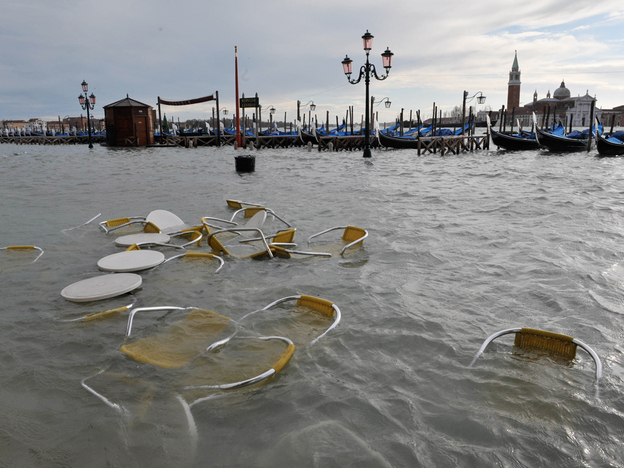Bar tables and chairs float in Venice in this December 2008 photo from the New Venice Consortium. On Dec. 1, 2008, Venice experienced its worst flooding in the last 22 years.
Bar tables and chairs float in flooded Venice. Piero Nascimbeni/New Venice Consortium/AP
Piero Nascimbeni/New Venice Consortium/AP
Bar tables and chairs float in Venice in this December 2008 photo from the New Venice Consortium. On Dec. 1, 2008, Venice experienced its worst flooding in the last 22 years.
text sizeAAA
September 20, 2009
The construction of mobile floodgates aims to safeguard the 1,300-year-old island city of Venice. It's an ambitious engineering project, but some scientists say it may not be sufficient to protect Venice from rising sea levels due to climate change.
Venice rose from mudflats in the middle of a lagoon which forms the largest wetland in the Mediterranean. One of the world's most endangered cities, it has been subject to increasing flooding due to sinking land — but also to rising sea levels.
It's known as "aqua alta" — high water — and it brings city life to a standstill for several hours. Big boats can't go under low-hanging bridges, and water seeps into buildings through the sewage system. Venetians have not lived on the ground floor for decades.
A mobile barrier under construction. Graziano Arici/New Venice Consortium/AP
Enlarge Graziano Arici/New Venice Consortium/AP
A mobile barrier is under construction at the Malamocco inlet to the lagoon of Venice in this November 2008 photo from the New Venice Consortium.
A mobile barrier under construction. Graziano Arici/New Venice Consortium/AP
Graziano Arici/New Venice Consortium/AP
A mobile barrier is under construction at the Malamocco inlet to the lagoon of Venice in this November 2008 photo from the New Venice Consortium.
Moses To The Rescue

A mobile barrier is under construction at the Malamocco inlet to the lagoon of Venice in this November 2008 photo from the New Venice Consortium.
Sophisticated technology is now being used for what has become a full-scale emergency. At one of the three inlets that lead from the sea into the lagoon, a massive mechanical hammer is driving a steel and concrete piling into the lagoon bed. Elena Zambardi works for the consortium safeguarding Venice and says the use of pilings was invented by the visionaries who founded the city 1,300 years ago.
 "Under the Salute bridge or Rialto Bridge," for example, "there are piles, wooden piles to consolidate the subsoil," she says.
"Under the Salute bridge or Rialto Bridge," for example, "there are piles, wooden piles to consolidate the subsoil," she says.Artist's rendering of how the mobile barriers work. Graziano Arici/New Venice Consortium/AP
Enlarge Graziano Arici/New Venice Consortium/AP
An artist's rendering of how the mobile barriers around Venice would work.
Artist's rendering of how the mobile barriers work. Graziano Arici/New Venice Consortium/AP
Graziano Arici/New Venice Consortium/AP
An artist's rendering of how the mobile barriers around Venice would work.
The project acronym is MOSE, which is also the Italian word for Moses, recalling the biblical parting of the sea.
Once completed in 2014, there will be 78 large, mobile flood gates at the three inlets. When not in use, they will sit on the lagoon bed. When a high tide is forecast, Zambardi says, the gates will rise and shut off the sea from the lagoon.
But the project, which is 54 percent completed, has been hounded by controversy and, critics say, may already be outdated.
The IPCC — the Intergovernmental Panel on Climate Change — has forecast a sea level rise by the end of this century of between 18 and 59 centimeters. But scientists caution it could be even higher.
An Ecosystem In Danger
Marine scientist Laura Carbognin has been studying the Venetian lagoon for decades. Like many scientists, she fears rising sea levels could mean the floodgates will be closed often and for long periods. That would upset the vital exchange between the sea and the lagoon, suffocating its delicate ecosystem.
Carbognin co-authored a report that suggests another radical solution: "To complement the Moses solution, it is necessary that all the city is uplifted."
She says research already suggests the feasibility of raising Venice.
"Based on hydrological and geochemical data, the preliminary simulation shows that fluid injection into deep formation can uniformly raise Venice up to 30 centimeters over 10 years," Carbognin says.
Carbognin hypothesizes the injections of salt water or even carbon dioxide at a depth of 600 to 800 meters below the lagoon, but she concedes much more research is needed.
That would mean huge investments at a time when delays in state funding for the more-than-$6-billion MOSE has already substantially delayed the project's completion.






